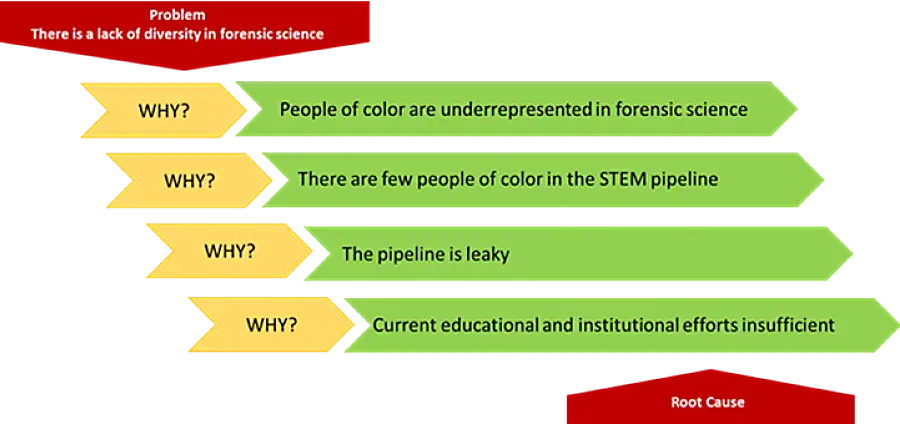
Merriam-Webster defines People of Color (POC) as: 1) a person whose skin pigmentation is other than and especially darker than what is considered characteristic of people typically defined as white , 2) a person who is of a race other than white or who is of mixed race.
This three-part blog series on POC in forensics will (1) examine the landscape of POC in forensics, (2) explore why POC are underrepresented in forensics, and (3) propose a path forward to increase representation.
Rooting out the problem: Why are POC underrepresented in forensic science?
The leaky pipeline theory emerged in the early 1990s when—in reference to women slowly leaving STEM fields throughout the education system and beyond—the director of women’s studies at the University of South Carolina stated that “the pipeline is leaking women.” Since then, the leaky pipeline theory has been expanded to refer to any underrepresented population in STEM. The theory postulates that members of certain demographics fail to progress toward particular careers, leading to underrepresentation.
To examine the potential root causes for the underrepresentation of POC in forensic science, we use a root cause analysis (RCA)—a common process in forensic laboratories to examine nonconformances in work products or processes. RCA explores the underlying cause-and-effect of problems by asking successive questions that lead to the root cause of the identified problem.
Why are POC underrepresented in forensic science?
Explaining the lack of diversity in forensic science requires a closer examination of the educational pipeline. We begin by evaluating the educational foundation available to POC during K–12, into undergraduate and graduate schools (Wagstaff and Laporte). Individuals who work as forensic scientists often have a bachelor’s degree or a Master of Science in chemistry or biology. The number of POC in the STEM pipeline is much lower than their White counterparts. A study from the Pew Research Center showed that Black and White students earned 7% and 67% of STEM bachelor’s degrees in 2018, respectively. The fewer POC in the STEM pipeline, the more underrepresented they will be in forensic science.
Why are few POC in the STEM pipeline?
The pipeline is based on the theory that the more exposure, mentorship, and support students get related to STEM in the early stages of schooling, the more likely students will be to continue advancing their education and careers in STEM fields (and thus forensic science). The lack of minorities in the STEM pipeline has been a topic of research for many years. Structural racism can sometimes impede the overall well-being of POC, further compounding issues that prohibit POC matriculation through the pipeline. RTI’s Racial Equity Institute suggests that Black individuals are subjected to myriad structural racism issues, such as inequalities in health care, a decrease in adequate educational opportunities, and insufficiency in generational finances that impact their foundation and affect their well-being. POC are often limited in their access to a quality education, STEM representation, familiarity with individuals who work in STEM careers, and a lack of encouragement to pursue science in school. These issues can lead to a leaky pipeline and the perceived lack of interest in STEM education and careers.

Although direct studies are not available on women’s and POC’s perception of forensics, studies do exist on the perception of careers in law enforcement among underrepresented populations. In a meta-analysis of the literature, Wiseman (2021) found that POC were not less likely to be interested in pursuing careers in law enforcement, but they did perceive more barriers than their White counterparts. One noted barrier was their concern over “fitting in” with the agency. Additionally, 28% of POC indicated that they experienced family disapproval of a career in law enforcement compared with 10% of their White counterparts. Although most forensic science positions are not directly associated with a law enforcement agency, and instead are independently managed and funded entities, POC may perceive that forensic science is just an extension of a criminal legal system that is in need of reform.
Why is the pipeline leaky?
One researcher tracked four cohorts of minority students in Florida and found large differences in math achievement by race as early as elementary school. If POC are not excelling in early STEM education, they may become discouraged and seek other educational opportunities. The study showed that poor achievement in STEM classes is often attributed to several factors that include the lack of quality STEM education, lack of parental support, and negative stigma. These stigmas often lead to the misconception that POC are underrepresented due to a lack of interest or ability (Wagstaff). This misconception contributes to the pipeline problem by perpetuating a false narrative that is often expressed as a microaggression by students and educational staff. The perception that POC are less capable or interested is ideologically flawed and without basis.
A 2010 study by the Bayer Corporation found that interest in science begins at an early age, regardless of gender, race, or ethnicity. Fifty-nine percent of students surveyed said they first became interested before age 11. The study also found that the lack of representation of POC is primarily due to discouragement along the educational and career pathways. Half of the Black men and Hispanic women surveyed indicated they were discouraged during their pursuit of a STEM career, with 60% of respondents indicating that college is where the discouragement occurred. Research has also demonstrated that collegiate racial climates contribute to the lack of domestic students of color in STEM programs, and Black students in STEM majors are more likely to experience racial microaggressions than other students of color. Even at the high school level, students cited condescension and assumed incompetence as factors contributing to their discouragement. Other factors included lack of racial representation, differential treatment of students based on race, and technology as a replacement for instruction. Under these circumstances, it is not surprising that the STEM pipeline “leaks” POC.
Why are current educational and institutional efforts insufficient?
The lack of diversity in STEM and forensic science suggests that a disintegration has occurred that alters the success rate of POC in STEM and forensic science. The basis for this disintegration is complex, but generally revolves around early childhood exposure to STEM. Literature suggests that to increase the representation of POC, an earlier interest in STEM must be nurtured and cultivated during K–12 and into college. In addition to the reinforcement of interest in STEM at an earlier age, mentorship and guidance must be available through graduate school (if applicable) and into early career for POC. Examples of exposure include encouragement by teachers, family members, and others to pursue STEM; mentorship throughout their education; increased awareness of the struggles of POC; and understanding and acknowledgment that societal systems and norms contribute to problems.
Culturally responsive teaching is an approach that challenges educators to recognize that, rather than deficits, students bring strengths into the classroom that should be leveraged to make learning experiences more relevant to and effective for them. — Gloria Ladson-Billings, American pedagogical theorist and teacher educator
It is difficult to identify widespread efforts to address these disparities for POC across educational and institutional systems. Most efforts are localized and often not highly publicized. Recently, some educators have begun using culturally responsive pedagogy (CRP), which centers education on students. The students’ unique cultural strengths are identified and nurtured to promote student achievement and a sense of well-being about the students’ cultural place in the world. Many of these initiatives have proven successful, but the downstream effects have yet to be fully studied. Nevertheless, the basic principles of CRP appear to address many of the leaky pipeline issues related to encouragement, negative stigma, and lack of exposure and would benefit from more in-depth research.
Learn more about RTI's work in equity-centered research and our Transformative Research Unit for Equity (TRUE).


